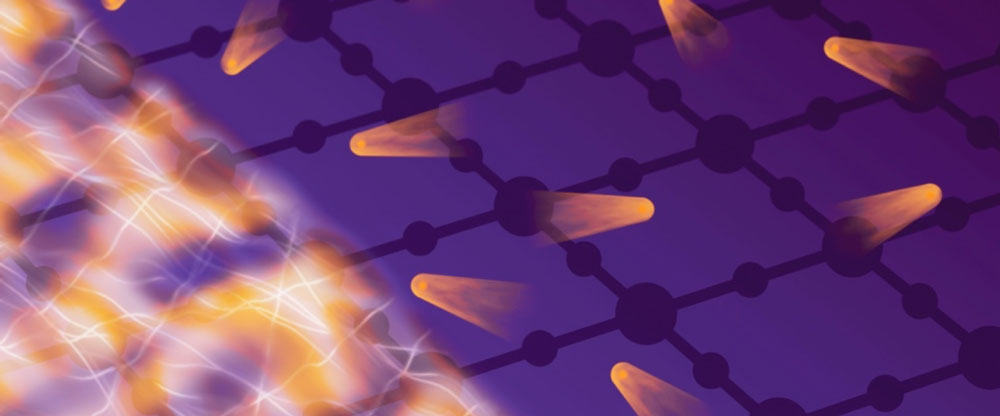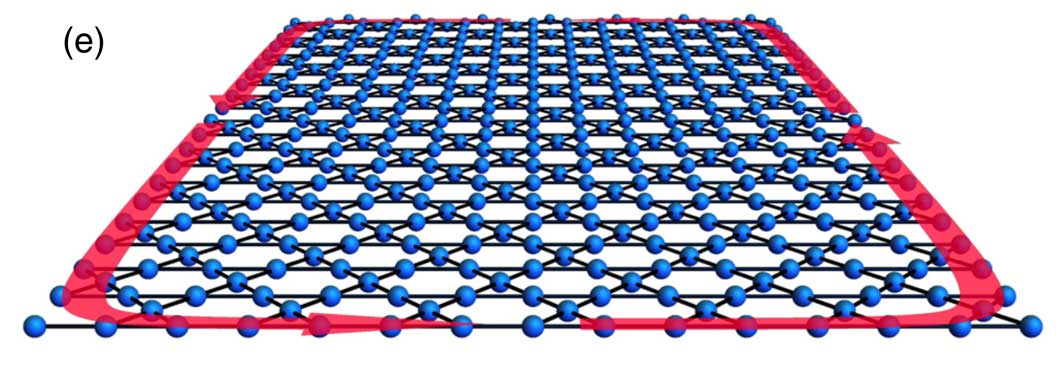Condensed Matter Physics & Quantum Materials

Normal state of a superconducting cuprate abruptly changing from a conventional metal (right) to the strange metal state (left).
(Shen group; Illustration by Greg Stewart/SLAC National Accelerator Laboratory)
Condensed matter research in the Department of Applied Physics explores the physics of quantum materials for fundamental science and next-generation technology
Quantum materials may have unusual properties which fall outside of conventional paradigms. A prime example is high-temperature superconductivity. We synthesize new compositions of matter and investigate their properties. In doing so, we hope to develop a fundamental understanding of the newly discovered ground states and the resultant excitations as well as the relationship between the electronic and atom structure within bulk materials and interfaces. These advances in our knowledge can then be utilized in important energy science and quantum information processors.
In energy science, materials with new superconducting, magnetic, and/or thermoelectric properties can be studied, where manipulation at the nanoscale can lead to novel functionalities beyond the bulk behavior (local vs global). We also seek new ways to probe and manipulate ultrafast energy flow and material transformations. Developing principles underlying limits on energy, speed and accuracy in communication and computation is also a goal.
In quantum information science, we discover and utilize novel quantum phases of matter. The exotic electronic and magnetic ground state properties (such as topological order), as well as resulting excitations, may be useful in fabrication of complex devices such as qubits for quantum information processing. We further develop different platforms that can maintain and manipulate quantum states of matter.
We also push the frontiers of next-generation measurements by developing new tools and facilities based on novel physics. We invent new ways to probe the nanoscale, collective behavior, and ultrafast time scales. Our research explores new measurements of fundamental properties (such as fundamental constants of nature) and promotes development of research facilities extending beyond single-investigator capabilities for interdisciplinary research.
Faculty:
- Ian Fisher
- Theodore Geballe
- Tony Heinz
- Harold Hwang
- Aharon Kapitulnik
- Young Lee
- Benjamin Lev
- Kathryn Moler
- David Reis
- Zhi-Xun Shen
- Yuri Suzuki
- Alfred Zong
- Malcolm Beasley
Courtesy Faculty:
Related programs:
- Geballe Laboratory for Advanced Materials (GLAM)
- Stanford Institute for Materials & Energy Sciences (SIMES)
- LINAC Coherent Light Source (LCLS)
- Stanford Nanofabrication Facility (SNF)
- Stanford Nanocharacterization Laboratory (SNL)
- Center for Magnetic Nanotechnology
- Stanford Synchrotron Radiation Lightsource (SSRL)
Visit Atomic, Molecular, and Optical Physics (AMO)
Visit Photonics
Visit Ultrafast and Accelerator Physics

Edge states of spin waves propagating on the kagome lattice (Lee group)

Topological magnon bands observed in the kagome ferromagnet Cu-(1,3-bdc) (Lee group)

Super-thin, flexible membrane created from normally brittle lanthanum calcium manganese oxide, revealing how strain affects the quantum material’s electronic properties. (Hwang Group; Illustration by Greg Stewart/SLAC National Accelerator Laboratory)

Scanning SQUID susceptometers with sub-micron spatial resolution, enabling simultaneous local measurement of magnetic flux and magnetic susceptibility (Moler group)

Phase diagram of Fe-based superconductor Co-doped BaFe2As2, showing the interplay of magnetic, superconducting, and nematic ordering (Fisher Group)
